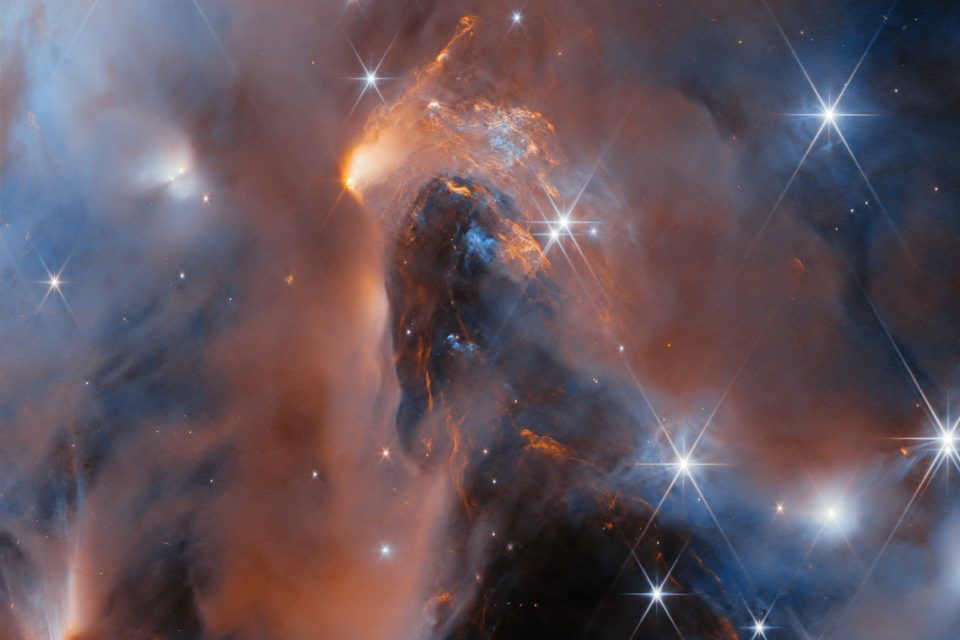Stellar nursery shines in the Perseus cloud
Today’s Image of the Day from the European Space Agency features NGC 1333, a reflection nebula located in the Perseus molecular cloud about 960 light-years away from Earth. The photo is a mosaic of images captured by the James Webb Space Telescope.
“Webb’s superb sensitivity allows astronomers to investigate young objects with extremely low masses. Some of the faintest ‘stars’ in the picture are in fact newly born free-floating brown dwarfs with masses comparable to those of giant planets,” noted ESA.
The same cluster was featured in the 33rd anniversary image of the Hubble Space Telescope in April 2023.
According to ESA, Hubble’s image just scratched the surface of this region, because clouds of dust obscure much of the star formation process.
“Observing with larger aperture and in the infrared part of the spectrum, Webb is capable of peering through the dusty veil to reveal newborn stars, brown dwarfs and planetary mass objects.”
Webb’s view of NGC 1333
ESA noted that the center of the image presents a deep peek into the heart of the NGC 1333 cloud.
“Across the image we see large patches of orange, which represent gas glowing in the infrared. These so-called Herbig-Haro objects form when ionized material ejected from young stars collides with the surrounding cloud. They are hallmarks of a very active site of star formation.”
The disks of gas and dust that surround the stars in this image may eventually produce planetary systems.
Stars in the Sun’s birth cluster
“Similar to the young stars in this mosaic, our own Sun and planets formed inside a dusty molecular cloud, 4.6 billion years ago. Our Sun did not form in isolation but as part of a cluster, which was perhaps even more massive than NGC 1333,” explained ESA.
Over time, the stars in the Sun’s birth cluster would have drifted apart due to gravitational interactions and the dispersion of gas in the region.
Astronomers have been studying certain clues, such as isotopic signatures in meteorites, that hint the Sun may have formed near massive stars. These stars likely produced supernovae, which could have influenced the early solar system by injecting heavy elements like iron-60.
Star formation in NGC 1333
NGC 1333 is a vibrant example of a stellar nursery, where active star formation is ongoing. It is known for its chaotic appearance, shaped by the interactions between newborn stars and the surrounding material.
Within NGC 1333, astronomers have observed a high level of turbulence, which makes the region dynamic and complex.
The disturbances are caused by the outflows of young stars as they eject material into their surroundings, creating shock waves and influencing further star formation.
These outflows are often seen as jets, which are visible in multiple wavelengths of light, especially infrared, as the surrounding dust absorbs visible light.
Early stages of planet formation
NGC 1333 is also an area of interest for studying the early stages of star and planet formation, as many of the stars within the cluster are in their infancy.
These stars are still in the process of gathering material and developing protoplanetary disks.
In images, NGC 1333 is marked by bright patches of blue and red, representing reflection nebulae and the ionized gas created by energetic young stars.
The Perseus molecular cloud
The Perseus molecular cloud is a vast region of cold gas and dust located about 600 light-years away from Earth in the constellation Perseus.
It is one of the most studied star-forming regions in our galaxy due to its relative proximity and the diversity of its young stellar objects. This cloud spans several hundred light-years and contains dense pockets of gas where new stars are actively forming.
These areas are often enshrouded in thick dust, which obscures them in visible light but allows astronomers to study them using infrared and radio wavelengths.
The Perseus molecular cloud is particularly interesting because of the chemistry taking place within it, including the formation of complex organic molecules that could be precursors to life.
Image Credit: ESA/Webb, NASA & CSA
—–
Like what you read? Subscribe to our newsletter for engaging articles, exclusive content, and the latest updates.
Check us out on EarthSnap, a free app brought to you by Eric Ralls and Earth.com.
—–




















